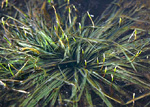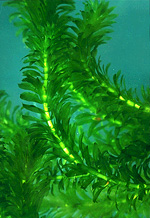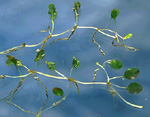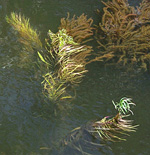 |
This small family of freshwater and marine plants is remarkably widespread, being absent only from the Arctic and from dry deserts. In Australia, members of the family may be found on calm coasts and estuaries almost throughout the coastline of the mainland and Tasmania, and in still or flowing, permanent fresh water, in all States.
Characteristic features of the family Hydrocharitaceae in Australia include: - marine or freshwater herbs with parallel-veined leaves either all submerged or floating or partially emergent, linear when submerged, often ovate when floating or emergent
- flowers small and inconspicuous or showy, borne either underwater or carried to the water surface by long (sometimes coiled) stalks, usually clasped by one or more prominent bracts
- perianth comprising 3 or 6 free parts, the inner sometimes petal-like
- stamens few or numerous, producing chain-like pollen (in the marine genera) or globular masses in the freshwater genera
- ovary inferior, developing into a dry or fleshy, dehiscent or indehiscent fruit with many small seeds
Description
Annual, biennial or perennial aquatic herbs rooted in the substrate with their leaves floating or emergent, perennating by rhizomes, crowns or turions (a short, condensed shoot, filled with starch). Vegetative reproduction absent or by rhizomes, stolons, or fragmented stems. Stem internodes solid or ?pithy. Internal secretions not obvious. Plants glabrous, or rarely with simple, non-glandular, unicellular hairs. Leaves alternate and spiral, distichous, or in whorls of 3–7 or more, cauline, or all or mostly basal, petiolate, subsessile, sessile or peltate. Stipule-like lobes absent. Lamina simple or rarely once compound and unifoliolate, symmetric, filiform, acicular, subulate, linear, lanceolate, ovate, elliptic, oblanceolate, ovate, oblong or orbicular; base cuneate, attenuate, rounded or cordate; margins entire or serrate, ±flat, involute, incurved or undulate; one-veined, or the venation palmate, or parallel, with the midrib conspicuous, and the tertiary venation reticulate or not; surfaces not punctate; herbaceous or membranous, rarely papery. Leaf ligule absent. Mostly with male and female flowers occurring on the same plant or on separate plants, or rarely with all the flowers bisexual. Inflorescences terminal or axillary, consisting of capitula or spadices, spikes, cymes or solitary flowers. Spathes present or absent. Bracts present or absent. Pollination by insects, wind or water. Flowers odourless; sessile or stalked. Floral disc absent; nectaries absent, or present on the stamens. Perianth regular, of 2 dissimilar whorls, of 1 whorl only or all whorls ±similar or vestigial or absent, with (2–) 3–6 segments. Calyx segments free, with (2–) 3 sepals, ?valvate in bud (when herbaceous), herbaceous or papery, sometimes modified into a pappus or consisting of bristles or scales. Corolla segments free, with 3 or 6 petals, alternating with the sepals, imbricate in bud, white, without contrasting markings, or streaked, spotted, etc, membranous; claws absent; lobes ±entire. Fertile stamens 1–3 (rarely 4 or 5), or 6–numerous, opposite to or alternating with or not clearly correlated with the sepals, free of the corolla, free or at least partly fused with the ovary and style, all ±equal. Staminodes rarely present. Staminal filaments present or absent. Anthers sometimes fused or grouped into bundles, or fused by the filaments, basifixed, opening by ?longitudinal slits, or rarely irregularly, outwards or sideways, not versatile, 2 or 4-celled. Ovary inferior. Carpels 1 or 3, free or fused; ovary with 1 locule. Style terminal, single and branched above or from the base. Ovules 3–numerous, sessile; placentation basal or parietal. Fruit dry or somewhat fleshy, dehiscent or indehiscent, a capsule with irregular or valvular dehiscence, or berry-like; the perianth on the maturing fruit deciduous, rotting or liquefying, or dry and persistent. Disseminule macro-surface featureless or with straight hairs, spines or awns; micro-surface ±smooth, spinulose, tuberculate or rugose, rarely reticulate, white, cream, yellow, green, brown, grey or black, glossy or dull. Seeds 2–numerous per fruit. Aril absent. Cotyledons 1. Embryo straight or curved, rarely coiled.
(Note: this description has been generated from the coded data compiled for the key. Any errors in the key data will be reflected in the descriptions.)
A treatment of the family Hydrocharitaceae has not yet been published in the Flora of Australia. It will appear in Volume 39.
Australian genera of Hydrocharitaceae (as recognised for the Flora of Australia)
* = all species introduced
Blyxa
*Egeria
*Elodea
Enhalus
Halophila
Hydrilla
Hydrocharis
*Lagarosiphon
Maidenia
Ottelia
Thalassia
Vallisneria

|
  |

Blyxa sp. (flowering plant)
Photo: S.Jacobs © S.Jacobs

Egeria densa (habit)
Photo: S.Jacobs © S.Jacobs

Halophila ovalis (habit)
Photo: S.Jacobs © S.Jacobs

Maidenia rubra (flowering plant)
Photo: D.Jones © D.Jones

|

| |